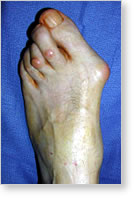
Synopsis
Rheumatoid
Arthritis can have significant effects on the feet and the ankle. These range
from swelling of the toe joints to severe destruction of the joints of the foot
and the ankle. The process of joint inflammation begins with an inflammation of
the lining of the joints called the capsule. As the capsule becomes inflamed,
the joint fills with fluid and becomes painful. The cartilage lining of the
joint may wear out.
The joint space becomes narrow and bone begins to rub on bone, leading to
painful arthritis. In addition, deformities may occur as a result of loosening
of the ligaments and capsule lining of the joint. If the housing of the joint
(the capsule) loosens up significantly, the joints (particularly in front of the
foot) may dislocate. This can cause painful swelling on the bottom of the ball
of the foot that can make walking terribly uncomfortable. In addition to the
dislocation of the joints, the big toe begins to deviate and bunions may form on
the inside of the big toe.
|
|
Treatment
and Prognosis
The treatment of this condition is two fold. The first goal is to keep the foot
as stable as possible and prevent further deterioration of the joints and
increasing deformity of the foot. The second goal is to obtain relief in walking
and make it easier to wear shoes. Unfortunately, as the deformity (particularly
of the toes) worsens, it becomes very difficult to proceed without surgery.
Surgery on the toes, particularly the knuckle joints of the toes (metatarso-phalangeal
joints), needs to be performed as soon as possible. This will prevent some of
the destructive changes of the joints from occurring. Although we are able to
treat even the most severe deformities of the toes, it is always preferable to
try to maintain the toe function and the toe movement. Surgery of the toes is
divided into those of the big toe (the hallux) and those of the little toes and
their joints (the lesser metatarso-phalangeal joints). As the deformity of the
big toe worsens, the most reliable procedure for correction is to fuse the
joint. This straightens the toe, provides a permanent correction to the
deformity and prevents any recurrent deformity or pain from arthritis. It is
however, possible to correct the big toe joint without a fusion, particularly if
the deformity can be addressed earlier on in the course of events.
The same applies to the lesser metatarsal phalangeal joints. If the joints are
severely dislocated and bone changes are present, the most reliable procedure is
to remove all of the metatarsals (the knuckles of the front of the foot). This
straightens the toes, relieves the curling or clawing of the toes and relieves
all of the terrible pressure under the ball of front of the foot. It is
preferable to try to maintain the joints without removing the knuckles. This can
be done with bone cuts (called osteotomies) of the metatarsals. These
osteotomies need to be performed early on in the disease process.
Rheumatoid arthritis also affects the back of the foot and the ankle joint.
Arthritis of these joints is often associated with flattening of the arch of the
foot. The ideal treatment would be to prevent these severe deformities from
occurring by performing surgery in the early stages of the condition. As the
deformity worsens, it becomes increasingly difficult to obtain a normally
aligned foot. Even with severe deformities, however, surgery can still be
performed. The foot is straightened with fusion of the joints of the back of the
foot. When rheumatoid arthritis involves the ankle joint, the ideal surgical
treatment is total ankle replacement. Although a fusion of the ankle joint is
possible and sometimes necessary, the majority of patients with rheumatoid
arthritis that involves the ankle joint do better with a total ankle replacement
then with a fusion. This is because the ankle joint is not the only joint
involved. Other joints of the back of the foot are also involved. For this
reason, it is preferable to maintain movement of the foot and ankle whenever
possible and avoid arthrodesis.